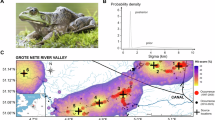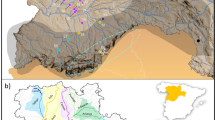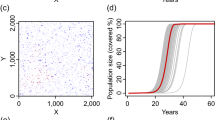Abstract
Rare long distance dispersal may have little impact on gene frequencies in established populations but it can dramatically increase gene flow during episodes of range expansion. We model the invasion of new territory by genetically distinct populations of the same species to investigate the dynamics of such episodes. If long distance dispersal is sufficiently frequent, the populations do not spread as a wave of advance but instead found intermingled isolates. We argue that this process can explain many otherwise puzzling patterns in the geographical distribution of alleles.
Similar content being viewed by others
Article PDF
References
Ammerman, A J, and Cavalli-Sforza, L L. 1984. The Neolithic Transition and the Genetics of Populations in Europe. Princeton University Press, Princeton.
Atkinson, W D, and Shorrocks, B. 1984. Aggregation of larval Diptera over discrete and ephemeral breeding sites: the implications for co-existence. Am Nat, 124, 336–351.
Avise, J L, Arnold, J, Ball, R M, Bermingham, E, Lamb, T, Neigel, J E, Reeb, C A, and Saunders, N C. 1987. Intraspecific phylogeography: the mitochondrial DNA bridge between population genetics and systematics. Ann Rev Ecol Syst, 18, 489–522.
Aylor, D E, and Ferrandino, E J. 1990. Initial spread of bean rust close to an innoculated bean leaf. Phytopathology, 80, 1469–1476.
Barton, N H. 1979. The dynamics of hybrid zones. Heredity, 43, 341–359.
Barton, N H, and Hewitt, G M. 1985. Analysis of hybrid zones. Ann Rev Ecol Syst, 16, 113–148.
Bennet, K D. 1988. Post-glacial vegetation history: ecological considerations. In: Huntley, B. and Webb. T. III (eds), Vegetation History, Kluwer, Dordrecht, pp. 699–724.
Butlin, R K, and Hewitt, G M. 1985a. A hybrid zone between Chorthippus parallelus parallelus and Chorthippus parallelus erythropus (Orthoptera: Acrididae): morphological and electrophoretic characters. Biol J Linn Soc, 26, 269–285.
Butlin, R K, and Hewitt, G M. 1985b. A hybrid zone between Chorthippus parallelus parallelus and Chorthippus parallelus erythropus (Orthoptera: Acrididae): behavioural characters. Biol J Linn Soc, 26, 287–299.
Butlin, R K, Ritchie, M G, and Hewitt, G M. 1991. Comparisons among morphological characters and between localities in the Chorthippus parallelus hybrid zone (Orthoptera: Acrididae). Phil Trans R Soc B, 334, 297–3087.
Cliff, A D, Haggett, P, Ord, J D, and Versey, G R. 1981. Spatial Diffusion, p. 27. Cambridge University Press, Cambridge.
Coope, G R. 1990. The invasion of Northern Europe during the Pleistocene by Mediterranean species of Coleoptera. In: di Castri, F., Hansen, A. J. and de Bussohe, M. (eds) Biological Invasions in Europe and the Mediterranean Basin, pp. 203–215. Kluwer, Dordrecht.
Dansgaard, W, Johnson, S J, Clausen, H B, and Langway, C C. 1971. Climatic records revealed by the Camp Century ice core. In: Turekian, K. K. (ed.) Late Cenozoic Glacial Ice Ages, pp. 36–37. Yale University Press, CT.
Endler, J. 1977. Geographic Variation, Speciation andClines. Princeton University Press, Princetown.
Ferris, C, Rubio, J M, Serrano, L, Gosalvez, J, and Hewitt, G M. 1993. One way introgression of a subspecific sex chromosome marker in a hybrid zone. Heredity, 71, 119–129.
Fisher, R A. 1937. The wave of advance of advantageous genes. Ann Eugen, 7, 355–369.
Gosalvez, J, Lopez-Fernandez, G, Bella, J L, Butlin, R K, and Hewitt, G M. 1988. A hybrid zone between Chorthippus parallelus parallelus and Chorthippus parallelus erythropus (Orthoptera: Arcrididae): chromosomal differentiation. Genome, 30, 656–663.
Gyllensten, V, and Wilson, A E. 1987. Interspecific mitochondrial DNA transfer and the colonization of Scandinavia by mice. Genet Res, 49, 25–29.
Harper, J L. 1977. Population Biology of Plants. Academic Press, London.
Harrison, R C, and Rand, D M. 1989. Mosaic hybrid zones and the nature of species boundaries. In: Otte, D. and Endler, J. A. (eds) Speciation and it Consequences, pp. 111–133. Sinauer Associates, Sunderland.
Hewitt, G M. 1975. A sex-chromosome hybrid zone in the grasshopper Podisma pedestris (Orthoptera: Acrididae). Heredity, 35, 375–385.
Hewitt, G M. 1979. Animal Cytogenetics III Orthoptera. Gebruder-Borntraeger, Stuttgart.
Hewitt, G M. 1989. The subdivision of species by hybrid zones. In: Otte, D. and Endler, J. A. (eds) Speciation and Its Consequences, pp. 85–110. Sinauer Associates, Sunderland.
Hengeveld, R. 1989. Dynamics of Biological Invasions, pp. 60–62. Chapman and Hall, London.
Huntley, B I, and Birks, H J B. 1983. An Atlas of Past and Present Pollen Maps for Europe: 0–13,000 Years Ago. Cambridge University Press, Cambridge.
Jones, J S, Bryant, S H, Lewontin, R C, Moore, J A, and Prout, T. 1981. Gene flow and the geographical distribution of a molecular polymorphism in Drosophila pseudoobscura. Genetics, 98, 157–178.
Mack, R N. 1981. Invasion in Bromus tectorum L. into western North America: an ecological chronicle. Agro-Ecosystems, 7, 145–165.
Mollinson, D. 1977. Spatial contact models for ecological and epidemic spread. J R Statist Soc B, 39, 283–326.
Nichols, R A. 1989. The fragmentation of tension zones in sparsely populated areas. Am Nat, 134, 969–977.
Nichols, R A, Humpage, E A, and Hewitt, G M. 1990. Gene flow and the distribution of karyotypes in the alpine grasshopper Podisma pedestris L. (Orthoptera, Acrididae). Biol San Veg Plagas(Fuera de serie), 20, 373–379.
Parker, J S, Lozano, R, Taylor, M, and Ruiz Rejon, M. 1991. Chromosomal structure of populations of Scilla autumnalis in the Iberian Peninsula. Heredity, 67, 287–297.
Pyle, G F. 1969. Diffusion of cholera in the United States. GeogAnal, 1, 59–75.
Shaw, D D, Coates, D J, Arnold, M L, and Wilkinson, P. 1985. Temporal variation in the chromosomal structure of a hybrid zone and its relationship to karyotypic repatterning. Heredity, 55, 293–306.
Shaw, D D, Marchant, A D, Arnold, M L, and Contreras, N. 1988. Chromosomal rearrangements, ribosomal genes and mitochondrial DNA: contrasting patterns of introgression across a narrow hybrid zone. In: Brandham, P. E. (ed.) Kew Chromosome Conference IV HMSO London, pp. 121–129.
Shorrocks, B. 1991. Competition on a divided and ephemeral resource: a cage experiment. Biol J Linn Soc, 43, 211–220.
Skellam, T G. 1951. Random dispersal in theoretical populations. Biometrika, 38, 196–218.
Van Den Bosh, E, Zadocks, J C, and Metz, J A J. 1988. FOCUS expansion in plant disease. II. Realistic parameter sparse models. Phytopathology, 78, 59–64.
Van Der Plank, J E. 1967. Spread of plant pathogens in space and time. In: Gregory, P. H. and Monteith, J. L. (eds) Airborne Microbes, pp. 227–247. Cambridge University Press, Cambridge.
Virdee, S R, and Hewitt, G M. 1990. Ecological components of a hybrid zone in the grasshopper Chorthippus parallelus (Zetterstedt) (Orthoptera: Acrididae). Bol San Veg Plagas (Fuera de Serie), 20, 299–309.
Wardle, J. 1974. Alpine timberlines. In: Ives, J. D. and Barry, R. G. (eds) Arctic and Alpine Environments, pp. 371–402. Methuen, London.
Author information
Authors and Affiliations
Rights and permissions
About this article
Cite this article
Nichols, R., Hewitt, G. The genetic consequences of long distance dispersal during colonization. Heredity 72, 312–317 (1994). https://doi.org/10.1038/hdy.1994.41
Received:
Issue date:
DOI: https://doi.org/10.1038/hdy.1994.41
Keywords
This article is cited by
-
Mechanisms of dispersal and colonisation in a wind-borne cereal pest, the haplodiploid wheat curl mite
Scientific Reports (2022)
-
Against all odds: a tale of marine range expansion with maintenance of extremely high genetic diversity
Scientific Reports (2020)
-
The hidden side of a major marine biogeographic boundary: a wide mosaic hybrid zone at the Atlantic–Mediterranean divide reveals the complex interaction between natural and genetic barriers in mussels
Heredity (2019)
-
Assessing the complex relationship between landscape, gene flow, and range expansion of a Mediterranean carnivore
European Journal of Wildlife Research (2019)
-
Genetic variation, demographic history and phylogeography of tire track eel, Mastacembelus favus (Synbranchiformes: Mastacembelidae) in Southeast Asia
Hydrobiologia (2019)



